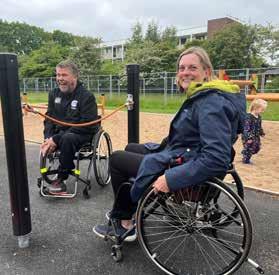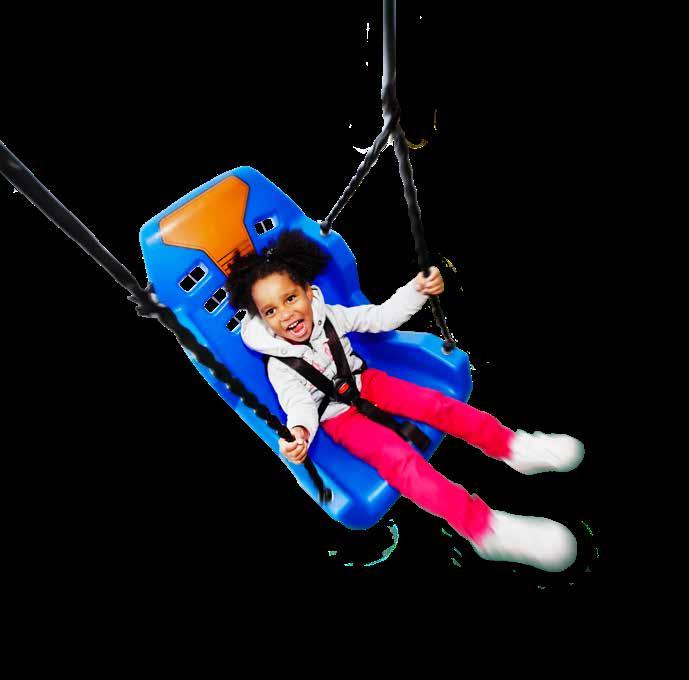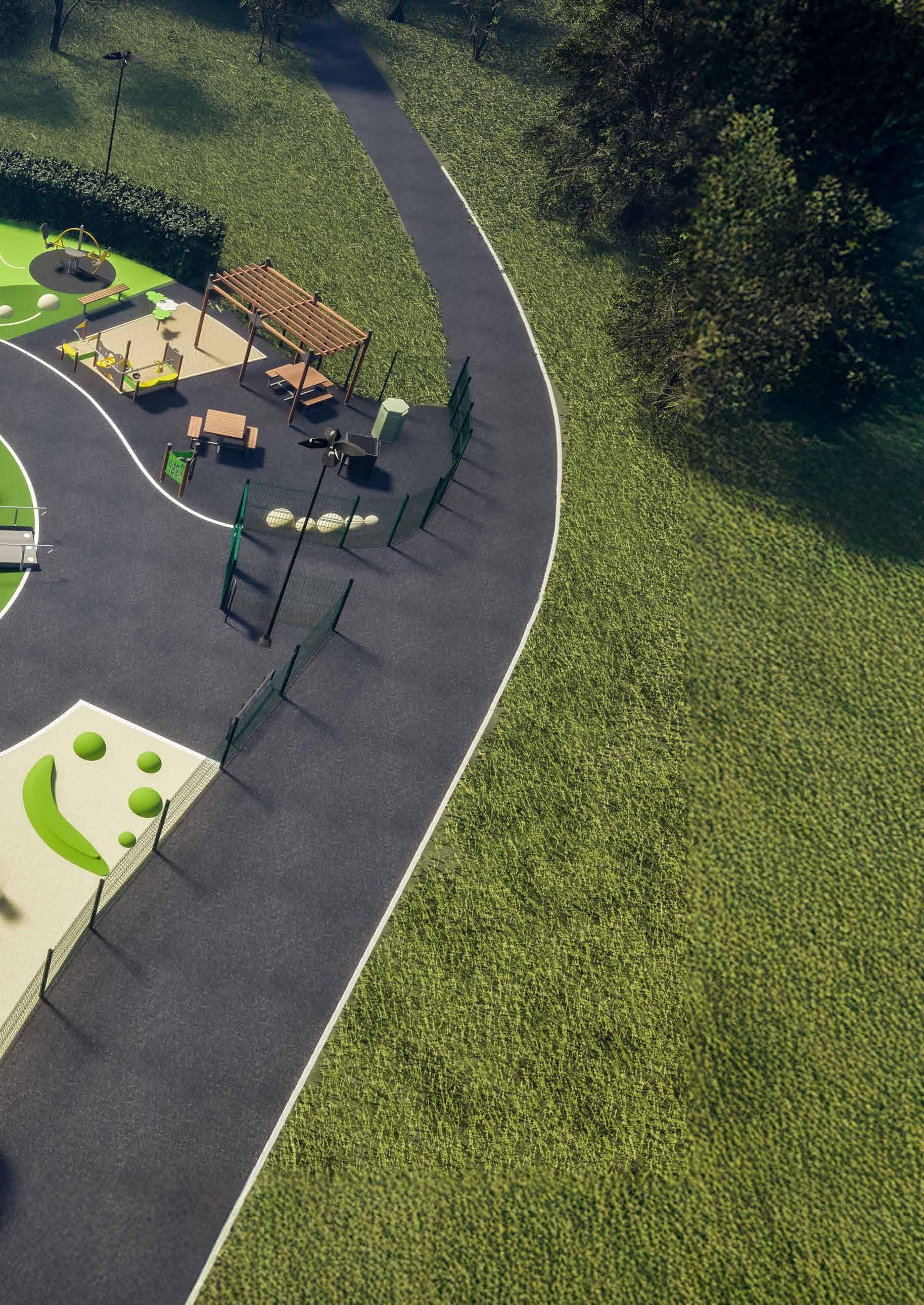
HAGS creates play & meeting spaces for inclusion, accessibility & joy


HAGS creates play & meeting spaces for inclusion, accessibility & joy
It is both fun and necessary for a child's development. By playing, children learn to understand the world around them. They learn social interaction and to communicate with others - to explore, experiment and test themselves. It teaches them cause and effect, risk assessment and making their own decisions.
They learn to share, improve strength and coordination, and develop their imagination and creativity. It's amazing that so many good things can come from something as fun as playing!
The playground is so much more than just play products. It’s an important place for integration where you can meet new and old friends, no matter what age. We believe that all children should be allowed to play, no matter what their background.
Creating accessible playgrounds can be difficult, but we believe that through good cooperation and planning, the perfect playground can be created. We hope that this brochure can inspire you to think, plan and create meeting places for everyone.



The playground should be a fun place for as many people as possible. It is through play that a child takes on the world and makes it comprehensible.
Not everyone can do everything, but there must be something for everyone.

A playground is so much more than just a place with play products. It's a place where you meet, make new friends and learn a lot of great things.
Through social interaction, children get to practice cooperation and to resolve conflicts. When a child dares to try new things, their courage and self-esteem develop.
These abilities are especially important for children with disabilities.

The feeling of being part of the game and not feeling left out is among the most important things.

It is important to vary challenges so that children with different abilities can be inspired at the same time.
Try to group similar equipment with varying degrees of difficulty next to each other.

Strong colours and contrasts are great for the visually impaired.


Hard surfaces make it possible to crawl, walk, run, bounce and roll together.
On hags.com you will find suggestions for play equipment which are great for some of the most common disabilities:
• ADHD
• Intellectual disability
• Visual impairment
• Autism
• Hearing loss

Scan me
We are happy to show you all the possibilities available to create places with play opportunities for everyone.
Play Experiences are also sometimes referred to as Play Values and describe the opportunity that an environment, object or piece of equipment brings to children’s experience of play.
Play Experiences are crucial to a child’s development and enjoyment of the play facilities.

Ramps, adapted swing seats, backrests and stairs increase accessibility.

The UN Convention on the Rights of the Child became law on January 1, 2020. It states that all children have the right to play in a stimulating, safe and accessible environment.
All children have the same rights and equal value.
All children have the right to express their opinion and be respected. 2 3 6 12 23 31
In addition to these four, we want to highlight two more of great importance from a play perspective.
The best interests of the child shall be taken into account in all decisions concerning children.
All children have the right to life and development.
Children with disabilities have the right to a full and decent life as well as help to actively participate in society.
Children have the right to play, rest and leisure.


The HAGS Play Pyramid is founded on years of international experience and insights from leading child development experts. It ensures maximum developmental benefits and provides an intuitive framework for designers, specifiers, and buyers to create inclusive, accessible play spaces for all children.
At the base of the HAGS Play Pyramid lies a foundation in play development areas. From these areas, play experiences grow, branching out in various directions. As these experiences evolve, they pass through different play enablers, each enhancing and enriching the play journey.
Ultimately, the benefits of play are shared widely, reaching many users and creating a vast, inclusive landscape of play. This approach ensures that play is accessible and beneficial to children of all abilities, fostering an environment of joy, growth, and inclusion.
In collaboration with


• Accommodates users with mobility impairments and wheelchair users.
• Rotating base is flush with the surrounding safety surface for seamless access.
• Supports both seated and standing users.
• Features two secure areas for wheelchair users



• Crocodile-shaped spring toy for children aged 2-5 years.
• Provides a fun and engaging rocking motion for young children.
• High backrest (550 mm) for enhanced comfort and stability.
• Equipped with a handle at the top of the backrest for adult support.
• Two accessible handles allow children to hold on firmly while rocking.
• Fully adjustable harness available, sold separately.

• Accessible to children with a wide range of developmental challenges.
• Designed for everyone, not just wheelchair users, promoting shared fun.
• Adapted supportive seat at wheelchair height for easy access.
• Handrail for self-propulsion for users with lower mobility.
• Backrest handles for parent/carer assistance when needed.

• Accessible for children of varying abilities.
• Built to withstand frequent use in diverse settings.
• Suitable for both educational and recreational environments.
• Promotes sensory exploration and creative play.
• Provides opportunities for hands-on, interactive learning.

• A timeless play structure that appeals to children of all ages.
• Encourages physical development through climbing and movement.
• Sparks creative and imaginative play.
• Provides opportunities for children to connect and collaborate.
• Offers a fun, stimulating, and safe environment for discovery and experimentation.
We are deeply thankful for all knowledgeable individuals who help us continually enhance accessible play. In Sweden we have a network that includes people with disabilities, parents of children with disabilities, and representatives from various organisations.
We consult with this network on the design of new products, customer requests, and other enquiries to ensure our knowledge is authentic and practical.



Why do all children have the right to play?
“According to Article 31 of the Convention on the Rights of the Child, all children have the right to play, rest and leisure. With this, play is an important part of children’s development, but it is also important not only that you have the right to play, but that you also get to play in a safe and secure environment, both physically but also socially”.
What does Milgott like to do in the playground?
“He loves to swing! It is often a sign he uses. He comes and says that he wants to swing and I think that I can understand that, it’s some kind of feeling of freedom that you sit where you feel the wind kind of hitting you and the tingling in your stomach that gets when you swing, it’s a nice feeling and I can see that feeling in him also when he actually swings”.
What do you usually do together on a playground?
“What we mostly do in playgrounds is play, chase each other, swing sometimes. They climb the climbing frame and I chase after them. We can also play kiosk”.

Helen Bergander Inclusion Coordinator/Designer HAGS, Sweden
We want play to be for everyone!
“We want to be part of creating inclusive playgrounds. A playground should be usable by as many people as possible, regardless of age or ability.
When we talk about inclusion, we are also talking about social aspects such as friendship, taking turns, and self confidence.”
Over the years, we’ve worked with children of all ages, cultures, and abilities to design products that embody our commitment to Play for All. By involving children directly in product development and play testing, we ensure our designs meet their needs.
At our testing sites in Sweden and the UK, our experts observe children at play, gathering feedback to refine each product for maximum enjoyment and benefit.








An inclusive playground is a welcoming, safe, and stimulating space for everyone. It offers diverse ways to play, with equipment that encourages jumping, climbing, sliding, and spinning, tailored to individual abilities. Open spaces allow for free movement and creative, self-directed play. The design promotes social, emotional, and physical experiences while embracing nature to enhance well-being.
1. Lighting extends playground visits, enhances safety, and aids orientation. Additional lighting near features like sandpits or climbing frames can improve visibility and enjoyment.
2. Ground-level spinners make play accessible to all, helping children develop coordination and body awareness.
3. Balance activities improve coordination and focus. Low-to-ground balancing equipment ensures more people can join in, while lane arrangements encourage prolonged play.
4. The Dennis Seesaw, with back and neck supports, is accessible, visually engaging, and fun. It accommodates children of varying strengths and abilities with its easy access and supportive design.
5. Raised sandboxes allow inclusive, imaginative play, suitable for both group and solo activities.
6. Provide shaded areas and weather protection for comfort and extended play.
7. Freely arranged tactile screens enable interactive play from multiple directions, allowing children to engage together or independently.
8. Clear, inviting entrances with tactile orientation signs ensure easy navigation for all.
9. The main attractions should offer diverse challenges. High-climbing features, ground-level activities, and sensory play elements (sight, sound, touch) create a playground for everyone. Features like shop counters promote imaginative group play.
10. The Snappy spring toy feature back supports, belts, and handles, enabling all children to enjoy swinging and rocking play.
11. Circular balance tracks encourage cooperation and social interaction.
12. Features like sand, spinning, and climbing challenge children while boosting coordination and focus.
13. Provide spaces to relax, eat, or socialize, offering a break from active play.
14. Use different swing seats to accommodate diverse needs.
15. Contrasting, easy-to-navigate paths and surfaces ensure inclusivity and help with orientation and accessibility.
16. Frame the playground with greenery to create a calming, welcoming environment.


Jönköping, Sweden

Arc en Ciel, France





In the idyllic setting of Lassagården, Sweden, lies a playground that brings the charm and adventure of farm life to children and families.
Inspired by Lassagården’s rich agricultural heritage, creating a playful environment that reflects the region’s rural roots.
The farm themed playground is a delightful mix of interactive play equipment that encourages children to explore, learn, and have fun.
With features such as tractor climbing units, trail play, and a specially designed UniPlay unit resembling a barn, this playground offers a unique and engaging experience.





Lassagården, Sweden



The Roman themed playground at the Seecamping Langlau campsite by Lake Brombachsee offers children an exciting and immersive play experience during their vacation.
The centerpiece of the playground is a large UniPlay structure designed to resemble Roman-era buildings along the Limes. This is complemented by a variety of individual play equipment, including a seesaw, nest swing, balance equipment, hammock and carousel.
It was also important to provide sufficient play opportunities for children with disabilities so that everyone can play together. All equipment on this playground follows this principle.







The Arc en Ciel Park, whose name translates to “Rainbow,” serves as a beacon of inclusivity and joy.
Located within the IME de Montaury base in Nîmes, this playground is part of a center run by the French Red Cross, dedicated to the care and support of children with multiple disabilities.
The Arc en Ciel playground was carefully designed with a focus on accessibility, inclusion, and sensory play. The selection of equipment ensures that children of all abilities can engage, whether through tactile exploration, auditory stimulation, or gentle motion.









Aberdeen City Council embarked on a mission to transform Hazlehead Park’s play area into a flagship inclusive play destination.
The park, divided into four themed sections, caters to different age groups and abilities, ensuring a highly inclusive environment.
Key features include a 12.5m high “Giant Redwood” tower and bespoke jungle themed play units. The “Inclusive Village,” developed with input from Sense Scotland, offers accessible items, musical elements, and quiet spaces.
Hazlehead playground now stands as one of the most inclusive playparks in Scotland, offering dynamic play experiences for children aged 1 to 12.







Club Hotel Aguamarina introduced a unique children’s play area, designed to enhance the vacation experience for families.
With a marine-themed playground inspired by the hotel’s mascots, the “Aguanimals,” the space offers fun and adventure for children of all ages while parents relax nearby.
Sand Zone (Ages 0-5): Focused on sensory and motor development, this area features see-saws, slides, and swings. The sand offers tactile experiences that stimulate balance, strength, and movement skills, while a castle-themed entrance adds a playful welcome to the space.
Rubber Zone (Ages 5+): The rubber-paved area includes more challenging play elements, such as climbing structures, spinning features, and a shipwrecked boat. This zone creatively transitions from deep-sea blues, representing Captain Evil’s boat, to the shore where the Aguanimals’ boat has landed. It also includes a hammock for quiet time and imaginative play.






1
Our free design consultation service offers personalised guidance tailored to your specific needs and preferences, ensuring that every aspect of your project is considered before implementation.
Step by step support
With step-by-step support, we accompany you through every stage of the design process, providing guidance, feedback, and assistance to ensure a smooth and successful execution of your project from start to finish.
2
We specialise in transforming your digital design concepts into tangible realities, leveraging cutting-edge technology and expert craftsmanship to bring your vision to life with precision and finesse.

Resources can be limited, It’s good to see how to make playgrounds better with simple measures.
1. Inventory of existing play
Who is the playground accessible for today? Think about accessibility based on the most common disabilities.
F Reduced mobility
F ADHD
F Intellectual disability
F Visual impairment
F Autism
F Hearing loss
2. Impairment of movement
F How is the surface around the play functions?
F Are there any games on the ground floor?
F Is it possible to replace some panels?
F Is it possible to change to various swing seats?
F Is the degree of difficulty varied?
F Is there room for a wheelchair on tables and benches?
F Are there openings in any border edges?
F Can sandboxes or sand tables be raised?
F Are there extra grip arches?
F Is it possible to get protection from the sun?
3. ADHD
F Are there physically challenging games, such as climbing games or obstacle courses?
F Is there an opportunity for fast-paced activities,
F such as swings or slides?
F Can you divide the play area into islands?
F Is it possible to separate play-intensive and calm areas?
4. Intellectual disability
It means that children often play until they're a lot older.
F Is the play equipment large enough?
F Are there clear and simple play functions?
5. Visual impairment
F Can orientation be strengthened with the help of beacons, such as wind chimes or water?
F Is it possible to create points of reference for orientation, for example with paths, shrubs or flower boxes?
F How do we create good lighting?
F Can we add a tactile information board?
F Can we create contrast markings on play stands,
F the beginning and end of the steps, handrails, etc.?
6. Autism
F Does the playground need to be enclosed with a fence?
F Is it possible to create a structure through colour?
F Can you make any part of the playground calmer?
F Are there things to play with that do not require cooperation?
7. Hearing loss
F Is it possible to add balance play, preferably close to the ground?
F Do you need to add visual information?
F Is it possible to minimize disturbing noise?
